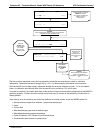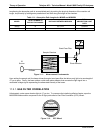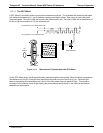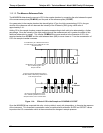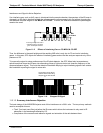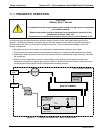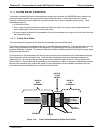
Teledyne API – Technical Manual - Model 300E Family CO Analyzers Theory of Operation
229
11. THEORY OF OPERATION
The M300E/EM Gas Filter Correlation Carbon monoxide Analyzer is a microprocessor-controlled analyzer that
determines the concentration of carbon monoxide (CO) in a sample gas drawn through the instrument. It
requires that the sample and calibration gases be supplied at ambient atmospheric pressure in order to establish
a stable gas flow through the sample chamber where the gases ability to absorb infrared radiation is measured.
Calibration of the instrument is performed in software and does not require physical adjustments to the
instrument. During calibration, the microprocessor measures the current state of the IR Sensor output and
various other physical parameters of the instrument and stores them in memory.
The microprocessor uses these calibration values, the IR absorption measurements made on the sample gas
along with data regarding the current temperature and pressure of the gas to calculate a final CO concentration.
This concentration value and the original information from which it was calculated are stored in one of the unit’s
internal data acquisition system (iDAS - See Sections 7.1) as well as reported to the user via a vacuum
floresce
nt display or a vari
ety of digital and analog signal outputs.
11.1. MEASUREMENT METHOD
11.1.1. BEER’S LAW
The basic principle by which the analyzer works is called the Beer-Lambert Law or Beer’s Law. It defines how
light of a specific wavelength is absorbed by a particular gas molecule over a certain distance. The
mathematical relationship between these three parameters is:
I = I
o
e
-αLc
Equation 11-1
Where:
I
o
is the intensity of the light if there was no absorption.
I is the intensity with absorption.
L is the absorption path, or the distance the light travels as it is being absorbed.
C is the concentration of the absorbing gas; in the case of the M300E/EM, Carbon Monoxide (CO).
α is the absorption coefficient that tells how well CO absorbs light at the specific wavelength of interest.
11.2. MEASUREMENT FUNDAMENTALS
In the most basic terms, the M300E/EM uses a high-energy heated element to generate a beam of broad-band
IR light with a known intensity (measured during instrument calibration). This beam is directed through
multi-pass cell filled with sample gas. The sample cell uses mirrors at each end to reflect the IR beam back and
forth through the sample gas a number of times (see Figure 11-1).
The total leng
th that the reflected lig
ht travels is directly related to the intended sensitivity of the instrument. The
lower the concentrations the instrument is designed to detect, the longer the light path must be in order to create
detectable levels of attenuation.
04288D DCN5752







